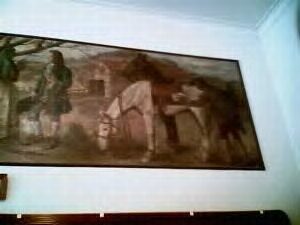
A picture speaks a thousand words. And surely this picture provides insight not only to the early landscape during the time of Colonel Heathcote's Richbell Estate, but it also provides insight into the myriad uses of enslaved labor by the early landbarons in Scarsdale, NY. as they began turning a tangled landscape into the much revered community Scarsdale has become today.
As Alfred Surya Peterson, SHS '52 described the role his ancestors played in working with horses at the Boulder Brook Riding Academy in Scarsdale, NY to me, it became clear that tradition of animal husbandry was just an extension of how life was unfolding during the early 1600s in Scarsdale. And the mural on the wall of the Scarsdale Post Office in the Village was just a reminder. Lest we forget, enslaved Africans were sought out because of the skills they had acquired prior to enslavement.
The dynamics of day-to-day labor by skilled enslaved Africans of the past reflects the existence of viable skills and abilities prior to the slave trade. i.e. Frederick Phillips of Philipsburg Manor, like many slavers, visited Madagascar to plunder its villages of Black Africans in an effort to find skilled workers. It was expedient for the slave owners to utilize these abilities to their own advantage. Planting, harvesting, hunting, brass casting, carving, weaving, building, fishing and sailing are only a few of the skills the enslaved African possessed which translated into financial success for the Philipse family and other slavers in the Americas.
Peterson related the following: "The Boulder Brook Riding Academy in Scarsdale, NY was managed by Leon Pitt, my cousin and one of my mentors, until he passed away. His brother and cousin worked for private owners at other riding stables in the Rosedale area of White Plains. They were horse trainers at the riding stables. The horses were well trained. Each year the men trained the riders who participated in the annual horse show at Madison Square Garden. The men provided a special service to the owners. And the men also cared for the horses as a veterinarian would. Lindsay Upshaw, was an equestrian (high jumper). He won awards at the Madison Square Garden horse show.
Peterson continues: "My younger cousin however became very good at it. Therefore, when he traveled to California, he worked as a horse trainer, grooming horses, etc. "
Gerald Johnson, a Purdy descendant, was a horse groomer for Secor Farms in White Plains. He worked as the stable manager for Saxon Woods Farms in White Plains, then as stable manager for Cedar Lodge Farms, Stamford, CT. until his retirement.
Gerald was a member of the Professional Horseman's Association and very well known and respected throughout the industry. He was the first African American member of the association. He received numerous awards throughout his career and won many trophies.
Leon Pitt one of my community mentors, a cousin and others worked in the stables. Leon Pitt was with the 758th Light Tank Regiment in Sicily, Italy. When Leon returned to the US, he began a career training horses at riding academies. He also worked for private owners. Leon taught others how to braid the horses' tails and manes for shows. He also rode in the horse shows. Leon's brother and cousin worked for private owners at other riding stables in the Rosedale area of White Plains, NY. They were horse trainers at the riding stables. A veterinarian was present for the Boulder Brook horses. The horses were well trained. Each year the men trained riders who for participation in the annual horse show at Madison Square Garden. The men provided a special service to the owners. And the men also cared for the horses as a veterinarian would," notes Peterson.
Scarsdale has so many vestiges of the African presence from its early beginning to the present. The Ghanian Sankofa symbol, embedded in an early coffin in Ole New York urges us to "Look to the past to understand the present and inform the future." Hence, we can begin this journey by reading the murals, paintings, headstones, and memorial walls because the history of Scarsdale has been carefully documented there. Scarsdale's African American history is documented in the Westchester Archives and the notes of Historians past and present; and the letters of our founding fathers.
John Henrik Clarke said it best: "History is not everything" John Henrik Clarke once wrote, "but it is the starting point. History is a clock that people use to tell their time of day. It is a compass they use to find themselves on the map of human geography. It tells them where they are, but more importantly, what they must be."
The African presence is as old as the village itself. And it is being unrolled today for understanding on the map of human geography.
Special acknowledgments: Alfred Peterson, Donna Lockley, Robinette Purdy Allen Robins

Leave a comment